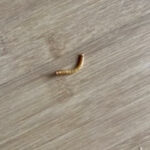
“I have this worm that is deep orange with black legs” writes this reader about a creature she found on her “passion vine”. Our reader does not provide any photographic evidence of these “worms”, but asks if we can let her know how she can get rid of them.

Besides what is written above, the only other information our reader provides about these “worms” is that they “love” her passion vine. Now, despite the lack of a photo, our reader’s description of the creatures’ physical appearance and the location in which they were found was enough to tell us that these “worms” are not worms at all, but milkweed assassin bugs. To be quite frank, this is likely one of the most interesting and bizarre names we have come across of an insect; the frightening nature of the “assassin” part of its name is completely undermined by “milkweed”. Nomenclature aside, the milkweed assassin bug is not all that frightening, nor is it a bug our reader may wish to get rid of at all. This is because the milkweed assassin bug is actually considered a beneficial insect to keep in one’s garden. This is because this creature is an insect predator, and will hunt down and eat many of the pests people deal with on a day-to-day basis, such as cucumber beetles, mosquitoes, and the infamous fall armyworm.
That being said, the milkweed assassin bug’s name is not unwarranted. The method by which it kills and consumes its prey is akin to how hammerhead worms kill their prey; first, the bug leaves behind a glue-like substance which coats its forelegs to slow down the prey, and then it will secrete a substance which paralyses the prey and dissolves its tissue, which can then be drunk by the bug through a straw-like mouth piece. Now, what our reader will want to be aware of is handling the milkweed assassin bug, for it can bite if it feels threatened. And when it does bite, it secretes the same substances into the human’s skin. Of course, our reader would not dissolve if bitten by this bug; the size difference between a human being and the prey of an assassin bug makes this physically impossible, but it will be painful and can cause a long-lasting stinging sensation, as well as a rash.
So, if our reader does not want these bugs in her garden, she will need to be careful when moving them. We recommend using a dustpan and not picking them off the plant by hand. Even so, we still would recommend wearing garden gloves and clothing that covers as much skin as possible, just in case. And the only method of getting rid of them that we will suggest is moving them; not only do we rarely recommend killing creatures (and almost never do we recommend the use of an insecticide), but since the milkweed assassin bug is considered environmentally beneficial, we would not even recommend that our reader try to get rid of them in the first place. They are most likely so passionate about our reader’s passion vine (pun intended) because there is plenty of prey already on the vine, potentially feeding on it. So, it might just be that the milkweed assassin bugs are the only thing keeping the vine alive, or at the very least, protecting it from a worse fate. Naturally, it goes without saying that this identification cannot be 100% certain without a photograph, so if our reader is positive that these bugs are actually harming her vine, then we recommend that she either send us photos so we can have another go at identifying the bugs and updating our advice, move the bugs to another location, or contact pest control.
In conclusion, the orange creatures with black legs are most likely milkweed assassin bugs, though we cannot be completely certain without any photographs. Nonetheless, we hope that this article proves helpful to our reader, and that this identification is correct, because if it is, then she does not have to do anything! If our reader does wish to confirm this identity and compare what she saw to pictures of the milkweed assassin bug, we recommend checking out the Galveston County Master Gardeners’ page Beneficials in the Garden and Landscape (from which the picture above was taken) and/or The University of Florida’s entomology and nematology page (linked are both of their pages on the milkweed assassin bug). These are also great resources if our reader wishes to find out more about this fascinating creature. We hope this helps and wish our reader the best of luck!
All About Worms is always free, always reader-supported. Your tips via CashApp, Venmo, or Paypal are appreciated! Receipts will come from ISIPP Publishing.
You might also find these guys interesting!

















